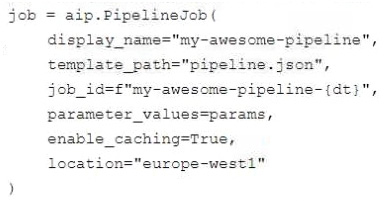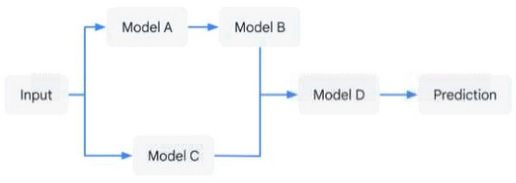Exam Details
Exam Code
:PROFESSIONAL-MACHINE-LEARNING-ENGINEERExam Name
:Professional Machine Learning EngineerCertification
:Google CertificationsVendor
:GoogleTotal Questions
:282 Q&AsLast Updated
:Jun 29, 2025
Google Google Certifications PROFESSIONAL-MACHINE-LEARNING-ENGINEER Questions & Answers
-
Question 161:
You developed a Vertex AI pipeline that trains a classification model on data stored in a large BigQuery table. The pipeline has four steps, where each step is created by a Python function that uses the KubeFlow v2 API. The components have the following names:

You launch your Vertex AI pipeline as the following:

You perform many model iterations by adjusting the code and parameters of the training step. You observe high costs associated with the development, particularly the data export and preprocessing steps. You need to reduce model development costs.
What should you do?
A. Change the components’ YAML filenames to export.yaml, preprocess,yaml, f "train-{dt}.yaml", f"calibrate-{dt).vaml".
B. Add the {"kubeflow.v1.caching": True} parameter to the set of params provided to your PipelineJob.
C. Move the first step of your pipeline to a separate step, and provide a cached path to Cloud Storage as an input to the main pipeline.
D. Change the name of the pipeline to f"my-awesome-pipeline-{dt}".
-
Question 162:
You have developed an application that uses a chain of multiple scikit-learn models to predict the optimal price for your company's products. The workflow logic is shown in the diagram. Members of your team use the individual models in other solution workflows. You want to deploy this workflow while ensuring version control for each individual model and the overall workflow. Your application needs to be able to scale down to zero. You want to minimize the compute resource utilization and the manual effort required to manage this solution. What should you do?

A. Expose each individual model as an endpoint in Vertex AI Endpoints. Create a custom container endpoint to orchestrate the workflow.
B. Create a custom container endpoint for the workflow that loads each model's individual files Track the versions of each individual model in BigQuery.
C. Expose each individual model as an endpoint in Vertex AI Endpoints. Use Cloud Run to orchestrate the workflow.
D. Load each model's individual files into Cloud Run. Use Cloud Run to orchestrate the workflow. Track the versions of each individual model in BigQuery.
-
Question 163:
You are an ML engineer at a manufacturing company. You are creating a classification model for a predictive maintenance use case. You need to predict whether a crucial machine will fail in the next three days so that the repair crew has enough time to fix the machine before it breaks. Regular maintenance of the machine is relatively inexpensive, but a failure would be very costly. You have trained several binary classifiers to predict whether the machine will fail, where a prediction of 1 means that the ML model predicts a failure.
You are now evaluating each model on an evaluation dataset. You want to choose a model that prioritizes detection while ensuring that more than 50% of the maintenance jobs triggered by your model address an imminent machine failure. Which model should you choose?
A. The model with the highest area under the receiver operating characteristic curve (AUC ROC) and precision greater than 0.5
B. The model with the lowest root mean squared error (RMSE) and recall greater than 0.5.
C. The model with the highest recall where precision is greater than 0.5.
D. The model with the highest precision where recall is greater than 0.5.
-
Question 164:
You built a custom ML model using scikit-learn. Training time is taking longer than expected. You decide to migrate your model to Vertex AI Training, and you want to improve the model's training time. What should you try out first?
A. Train your model in a distributed mode using multiple Compute Engine VMs.
B. Train your model using Vertex AI Training with CPUs.
C. Migrate your model to TensorFlow, and train it using Vertex AI Training.
D. Train your model using Vertex AI Training with GPUs.
-
Question 165:
You are an ML engineer at a retail company. You have built a model that predicts a coupon to offer an ecommerce customer at checkout based on the items in their cart. When a customer goes to checkout, your serving pipeline, which is hosted on Google Cloud, joins the customer's existing cart with a row in a BigQuery table that contains the customers' historic purchase behavior and uses that as the model's input. The web team is reporting that your model is returning predictions too slowly to load the coupon offer with the rest of the web page. How should you speed up your model's predictions?
A. Attach an NVIDIA P100 GPU to your deployed model's instance.
B. Use a low latency database for the customers’ historic purchase behavior.
C. Deploy your model to more instances behind a load balancer to distribute traffic.
D. Create a materialized view in BigQuery with the necessary data for predictions.
-
Question 166:
You work for a small company that has deployed an ML model with autoscaling on Vertex AI to serve online predictions in a production environment. The current model receives about 20 prediction requests per hour with an average response time of one second. You have retrained the same model on a new batch of data, and now you are canary testing it, sending ~10% of production traffic to the new model. During this canary test, you notice that prediction requests for your new model are taking between 30 and 180 seconds to complete. What should you do?
A. Submit a request to raise your project quota to ensure that multiple prediction services can run concurrently.
B. Turn off auto-scaling for the online prediction service of your new model. Use manual scaling with one node always available.
C. Remove your new model from the production environment. Compare the new model and existing model codes to identify the cause of the performance bottleneck.
D. Remove your new model from the production environment. For a short trial period, send all incoming prediction requests to BigQuery. Request batch predictions from your new model, and then use the Data Labeling Service to validate your model's performance before promoting it to production.
-
Question 167:
You want to train an AutoML model to predict house prices by using a small public dataset stored in BigQuery. You need to prepare the data and want to use the simplest, most efficient approach. What should you do?
A. Write a query that preprocesses the data by using BigQuery and creates a new table. Create a Vertex AI managed dataset with the new table as the data source.
B. Use Dataflow to preprocess the data. Write the output in TFRecord format to a Cloud Storage bucket.
C. Write a query that preprocesses the data by using BigQuery. Export the query results as CSV files, and use those files to create a Vertex AI managed dataset.
D. Use a Vertex AI Workbench notebook instance to preprocess the data by using the pandas library. Export the data as CSV files, and use those files to create a Vertex AI managed dataset.
-
Question 168:
You developed a Vertex AI ML pipeline that consists of preprocessing and training steps and each set of steps runs on a separate custom Docker image. Your organization uses GitHub and GitHub Actions as CI/CD to run unit and integration tests. You need to automate the model retraining workflow so that it can be initiated both manually and when a new version of the code is merged in the main branch. You want to minimize the steps required to build the workflow while also allowing for maximum flexibility. How should you configure the CI/CD workflow?
A. Trigger a Cloud Build workflow to run tests, build custom Docker images, push the images to Artifact Registry, and launch the pipeline in Vertex AI Pipelines.
B. Trigger GitHub Actions to run the tests, launch a job on Cloud Run to build custom Docker images, push the images to Artifact Registry, and launch the pipeline in Vertex AI Pipelines.
C. Trigger GitHub Actions to run the tests, build custom Docker images, push the images to Artifact Registry, and launch the pipeline in Vertex AI Pipelines.
D. Trigger GitHub Actions to run the tests, launch a Cloud Build workflow to build custom Docker images, push the images to Artifact Registry, and launch the pipeline in Vertex AI Pipelines.
-
Question 169:
You are working with a dataset that contains customer transactions. You need to build an ML model to predict customer purchase behavior. You plan to develop the model in BigQuery ML, and export it to Cloud Storage for online prediction. You notice that the input data contains a few categorical features, including product category and payment method. You want to deploy the model as quickly as possible. What should you do?
A. Use the TRANSFORM clause with the ML.ONE_HOT_ENCODER function on the categorical features at model creation and select the categorical and non-categorical features.
B. Use the ML.ONE_HOT_ENCODER function on the categorical features and select the encoded categorical features and non-categorical features as inputs to create your model.
C. Use the CREATE MODEL statement and select the categorical and non-categorical features.
D. Use the ML.MULTI_HOT_ENCODER function on the categorical features, and select the encoded categorical features and non-categorical features as inputs to create your model.
-
Question 170:
You need to develop an image classification model by using a large dataset that contains labeled images in a Cloud Storage bucket. What should you do?
A. Use Vertex AI Pipelines with the Kubeflow Pipelines SDK to create a pipeline that reads the images from Cloud Storage and trains the model.
B. Use Vertex AI Pipelines with TensorFlow Extended (TFX) to create a pipeline that reads the images from Cloud Storage and trains the model.
C. Import the labeled images as a managed dataset in Vertex AI and use AutoML to train the model.
D. Convert the image dataset to a tabular format using Dataflow Load the data into BigQuery and use BigQuery ML to train the model.
Related Exams:
ADWORDS-DISPLAY
Google AdWords: Display AdvertisingADWORDS-FUNDAMENTALS
Google AdWords: FundamentalsADWORDS-MOBILE
Google AdWords: Mobile AdvertisingADWORDS-REPORTING
Google AdWords: ReportingADWORDS-SEARCH
Google AdWords: Search AdvertisingADWORDS-SHOPPING
Google AdWords: Shopping AdvertisingADWORDS-VIDEO
Google AdWords: Video AdvertisingAPIGEE-API-ENGINEER
Apigee Certified API EngineerASSOCIATE-ANDROID-DEVELOPER
Associate Android Developer (Kotlin and Java)ASSOCIATE-CLOUD-ENGINEER
Associate Cloud Engineer
Tips on How to Prepare for the Exams
Nowadays, the certification exams become more and more important and required by more and more enterprises when applying for a job. But how to prepare for the exam effectively? How to prepare for the exam in a short time with less efforts? How to get a ideal result and how to find the most reliable resources? Here on Vcedump.com, you will find all the answers. Vcedump.com provide not only Google exam questions, answers and explanations but also complete assistance on your exam preparation and certification application. If you are confused on your PROFESSIONAL-MACHINE-LEARNING-ENGINEER exam preparations and Google certification application, do not hesitate to visit our Vcedump.com to find your solutions here.